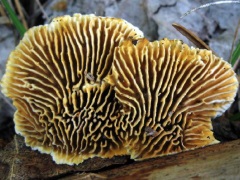Features
A flexible friend in fungi
Date: 2017-07-28 16:41:44.0
Author: Jon Evans

Basidiomycota brown rot fungi.
Photo: Karel Tejkal, used with permission.
Many species of fungi are known for their ability to feed on dead plant biomass, by releasing cellulases and other enzymes that convert the cellulose in the biomass to simple sugars such as glucose. Indeed, versions of these fungal enzymes form the basis for the enzyme packages that are used to break down plant biomass for the production of cellulosic ethanol.
Recently, however, scientists have discovered that fungi are actually more flexible than they originally realized, able to adopt several different approaches to breaking down plant biomass. These range from organizing enzymes in a novel way to doing away with enzymes almost entirely.
Biomass-degrading fungi generally just secrete the necessary enzymes onto the biomass, but this is not particularly efficient, because several different enzymes usually need to work in tandem to break down the biomass. In contrast, some species of biomass-degrading bacteria package the enzymes in a single multiprotein complex known as a cellulosome. This ensures that all the necessary enzymes are always in close proximity, making it easier for them to work together and improving the efficiency with which the biomass is broken down.
In a recent paper in Nature Microbiology, an international team of scientists led by Michelle O'Malley at the University of California, Santa Barbara, US, used various genomic and proteomic techniques to confirm that cellulosomes are also employed by certain species of biomass-degrading gut fungi. And, if anything, their cellulosomes are even better than those employed by bacteria.
That’s because the cellulosomes produced by each species of bacteria will only accept enzymes produced by that species. In contrast, O’Malley and her team found that fungal cellulosomes are less picky, willing to accept enzymes produced by other species of fungi. This implies that fungal cellulosomes may be easier to modify than bacterial cellulosomes, potentially allowing the creation of artificial versions that can convert biomass directly into biofuels and other useful chemicals.
Still, enzymes are not always ideal workers, as they are expensive to produce and easily deactivated by harsh operating conditions, but there may be another option. In a new paper in Biotechnology for Biofuels, an international team led by Barry Goodell at the University of Massachusetts, Amherst, US, report that brown rot fungi employ a completely different tactic.
Rather than enzymes, they use the highly-reactive molecule hydrogen peroxide, generated by an iron-containing compound, to break down plant biomass, especially wood. Scientists knew that brown rot fungi could do this, but they thought the hydrogen peroxide merely punched holes in plant cell walls to allow cellulases and other enzymes access to the cellulose. But Goodell and his team have now shown that hydrogen peroxide actually leaves the cell wall fairly intact and instead directly breaks down both cellulose and lignin.
"This group of brown rot fungi figured out how to generate hydroxyl radicals at a distance, that is, away from the fungus, to keep them away so the radicals won't damage themselves while breaking down wood," explains Goodell. The fungi still use a few enzymes, but only to break down oligosaccharides released by the breakdown of cellulose and lignin.
The reaction employed by the fungi, in which an iron-based compound generates hydrogen peroxide, is known as the chelator-mediated Fenton reaction and is already widely used to break down organic compounds in wastewater. This indicates that it should be fairly straightforward to adapt for biofuel production.
Goodell suggests that it could offer a cheaper and more efficient way to break down biomass than current acid or stream treatments, which only release the cellulose and don’t break it down into simple sugars. While enzymes would probably still be required to completely convert all the cellulose and hemicellulose into glucose, the amounts required should be less, especially if they were packaged in cellulosomes.
The views represented here are solely those of the author and do not necessarily represent those of John Wiley and Sons, Ltd. or of the SCI.
Displaying 8 keywords used to tag this article:
- Replica Audemars Piguet Watch City
- New Balance 1400 :
- Relojes AAA Replica Cartier
- Replica Rolex Datejust Lady 31 Watc
- Links Of London Charmes
- 2014 New! Moncler Down Coat Women H
- Copy Rolex Air-King Fasion Precisio
- Patek Philippe klockor Storbritanni
